NBA Elite 11 iPhone Impressions
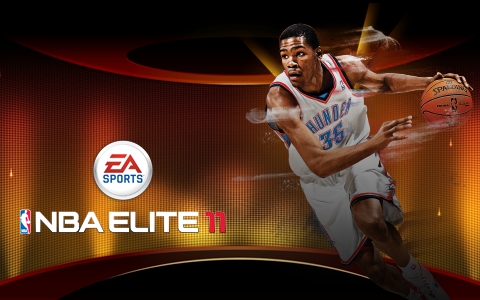
By Brian Sipple
Last week’s obituary for NBA Elite 11 on the major platforms came as no surprise after all the tribulation the series has faced in recent months. A few loyal fans will tell you that they were really looking forward to EA’s newly reinvented franchise, and that the game was only canceled because it was deemed to have too much awesomeness for public consumption. For the most part though Elite received constant criticism throughout its development, culminating with the release of a bug-filled demo that saw words like “disaster” and “dumpster fire” overrunning message boards around the internet.
Thus, NBA Elite takes its talents so to speak to the App Store at a price of $4.99. Its release makes it the only 5-on-5 basketball offering from EA Sports on any platform, and also the only outlet for a true 5-on-5 NBA experience on your mobile device. While you might not expect much after the ugly precedent set by its console counterpart, the iOS version of Elite happens to be a surprising success on quite a few fronts.
Part of what makes Elite fun is a strong control scheme that, like any touch game, contributes enormously to the gameplay experience. The first time you start up the game you’re taken through a tutorial mode to get acquainted with the basic and advanced control systems. It’s quick, it’s simple, it’s effective, and it will get you on the court in less time than it takes for John Wall to Dougie there.
I loved the use of the floating d-pad which appears wherever and whenever you touch the left half of the screen. Assuming instant control of a selected player is a breeze and you don’t have to worry about where your thumb is throughout the whole game. It’s just the right size to allow for slower or more precise movement while letting you drag outward for running. You can also do so by double tapping the d-pad and then dragging outward, which seems a little sketchy but handles rather easily.
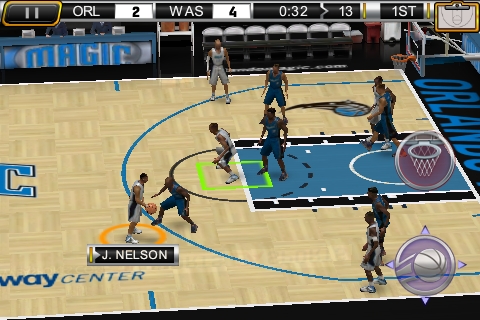
The right portion of the screen is equally simplistic yet just as effective, with just two buttons that perform all of your actions. For example, on offense the red button controls shooting aspects by tapping to pump fake and holding to shoot or dunk (dunking requires being in a close enough vicinity under the rim, which varies from player to player – sorry Carlos Boozer). The blue button controls handling aspects by tapping to pass in a direction controlled by the d-pad, holding to select a specific passing target, or flicking to perform various trick moves. There’s also a strategy clipboard at the upper right of the screen that pauses the game while you select a desired play.
All of these offensive controls mesh into a deep, but clean setup that flows smoothly with the pace of the gameplay. It allows players to pick up the game right away and stress whatever style of play they choose to employ. The AI does a good job of handling their assignments and will often work to set up picks or three point openings even if you don’t call for them. Also shooting is a vast improvement from last year, as it’s challenging enough to the point where you can be great with practice, just not exploitive.
If there is one flaw in the gameplay though it might be the on the defensive side of the ball. Controls are just as smooth and easy here too, and the defensive AI certainly knows how to play against their opponent. There’s just not much emphasis on challenging the other team’s ball security. Passing is too easy and steal attempts almost never work. I also noticed an issue where dunking goes practically unopposed once a player is in position for the action to be initiated. Granted, it’s easier to work the paint and get under the rim with the appropriate players like Dwight Howard. Though if JJ Reddick were to find a way to get within his personal dunk range, make no mistake, he will not be denied. It’s hard for someone to take advantage of this and turn it into a game plan, but it does create some intrusive moments that feel out of place.
Graphically speaking Elite is another strong offering from EA that takes full advantage of the iPhone 4’s retina display. Player models are very sharp and crisp while facial likenesses are distinguishable among each player. The impressive lighting and color palate also helps to create a vibrant atmosphere on the court, which is further enhanced by the game’s fluent frame rate.
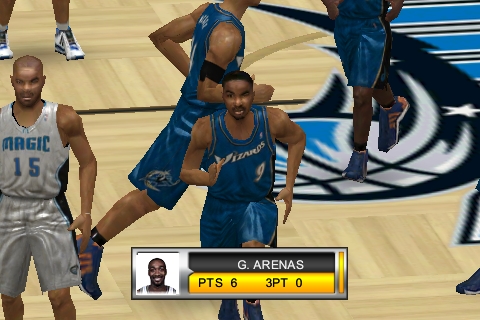
The only downside is that this seems to have been done at the expense of the surroundings. The team benches are completely empty and the upper levels of each stadium are darkened out with no visible crowd. Oddly enough, when you play at a Nets home game, the game doesn’t even bother rendering the fans at all (just kidding).
Even though the 360 and PS3 versions of Elite were supposed to feature commentary from ESPN’s Mike Breen, Mark Jackson, and Jeff Van Gundy, Breen is on his own for the iOS version and it really makes the commentary seem empty. That’s disappointing considering EA already has the trio’s work on file and there are sound bites that couldn’t be used past this year anyway. While Breen does make accurate calls and never any major gaffes, he never has a whole lot to say overall.
Thankfully though other parts of the presentation are more polished. Spirited crowds will cheer and chant incessantly if you play well but won’t hesitate to get the boo chorus started up if you aren’t giving them their money’s worth. You can also hear the guy who thinks he’s Pat Riley after a couple of Buds shout gems such as “Play like you want it!” or “Let’s do this!”
There are also 3 unique camera angles that let you view the action from a different angle. The tried and true broadcast mode will likely be the choice or most. However a baseline and corner camera are available, and they can offer some unique perspectives to enhance your vision across the length of the court.
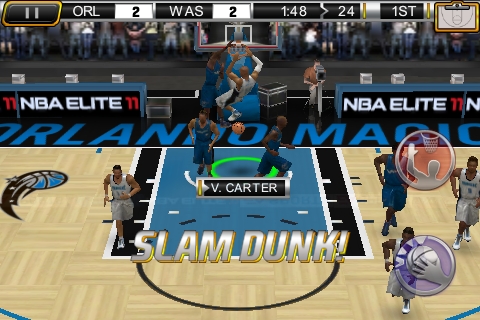
Aside from a quick game, franchise and playoff modes form the foundation for Elite’s game modes. Within each mode you can unlock legendary players, including Gary Payton, Dr. J, and Bill Russell by completing certain challenges. It’s all controlled through a beautifully designed interface that comes with a great sound track as well. Nothing here represents any drastic changes from last year, but there’s enough to provide hours of enjoyment for even casual basketball fans.
Additionally there is the inclusion of an addicting three-point shootout mode where you can just play for fun or try to score 30 points and unlock a legend. It can be hard to put down, and it also made me laugh to think back to just a few years ago when we used to pay $2 for a standalone, cartoonish app like this.
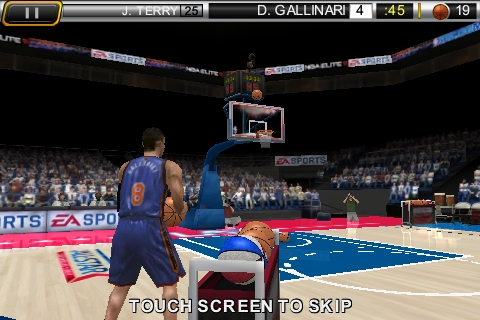
Multiplayer still fails to make an appearance though, and that’s too bad. It seems like a lot of wasted potential considering how fun the rest of the game can be. A lot of work was put into polishing the gameplay experience, and I would think that next year’s game should almost certainly be prepared to include the feature.
I don’t want to see a team’s star player get hurt before the season even starts, but the fact that multiplayer is glaringly absent from the game will be enough to turn off some regardless of what the rest of this review might state. It is disappointing that its nearing 2011 and such a feature isn’t a shoe-in for a big name / big sport title like Elite.
That being said, Elite is a very well rounded NBA experience that still offers plenty for a $5 price point. I can honestly say that I was taken aback as to how fine-tuned the control scheme is; it’s probably about as good as you can get for a touch-based game. Add in some pretty graphics and fairly realistic gameplay and it’s clear that this isn’t just a patchwork, mailed-in port from its console iteration. It deserves to be seen in an unbiased light despite the struggles currently being faced by the franchise.
Thanks to Brian Sipple for taking the time to put together the impressions of the mobile version of NBA Elite 11 – PP
